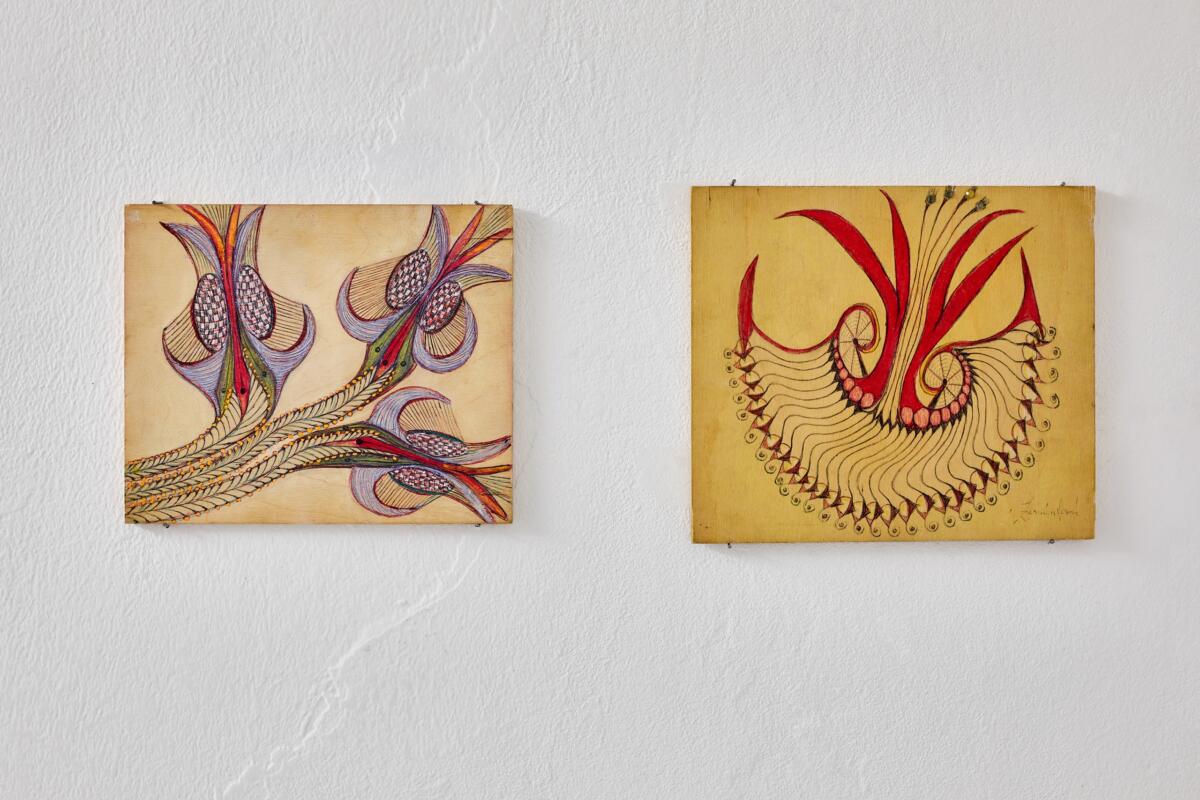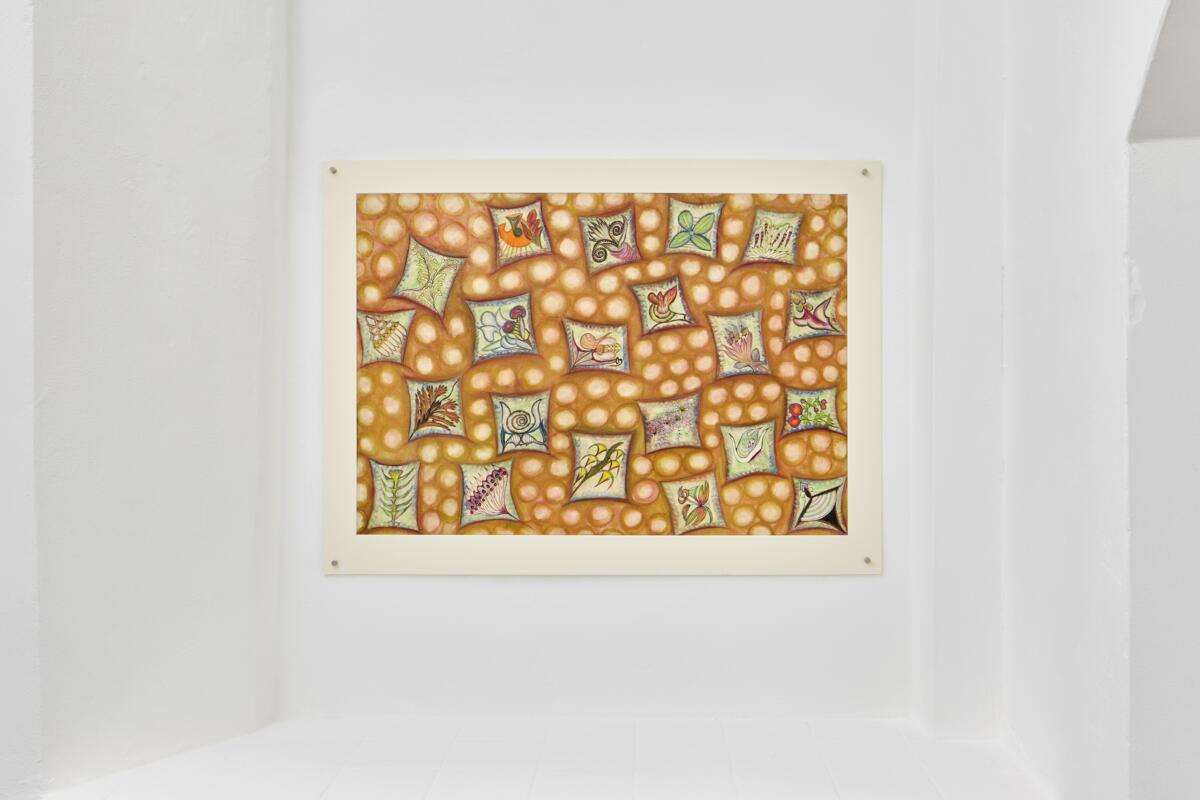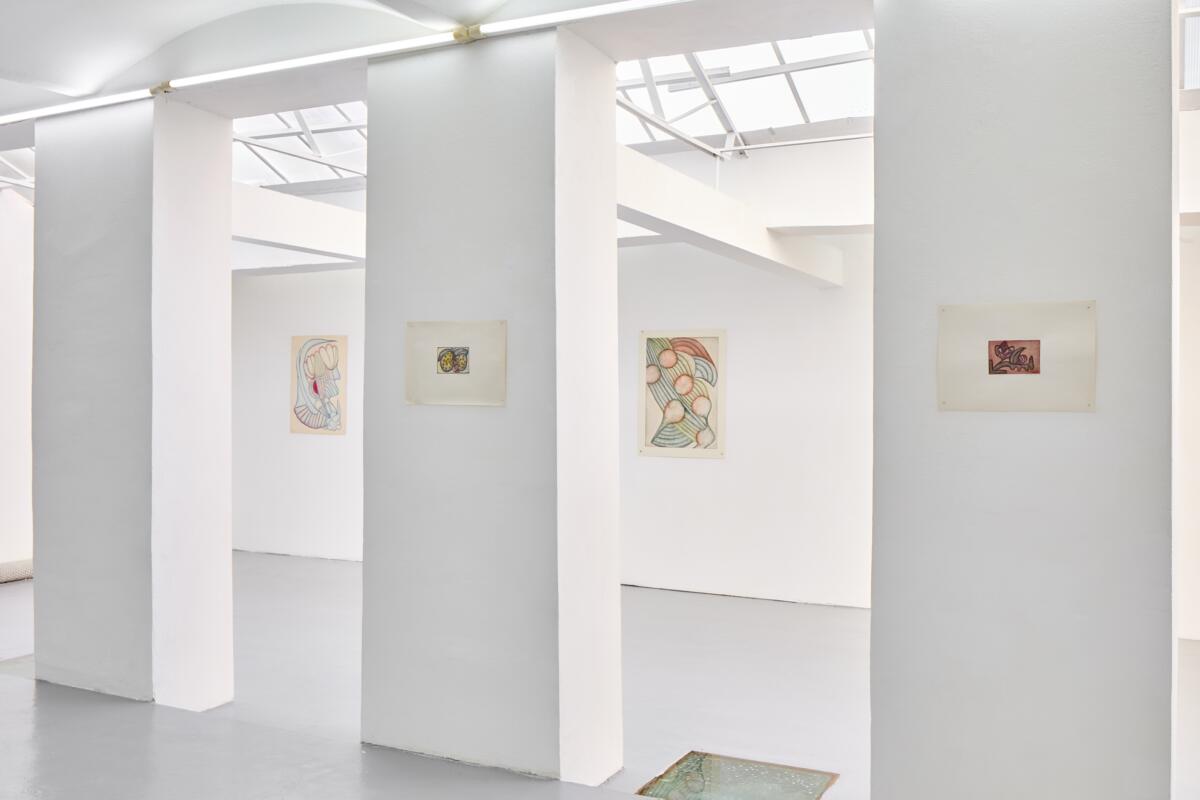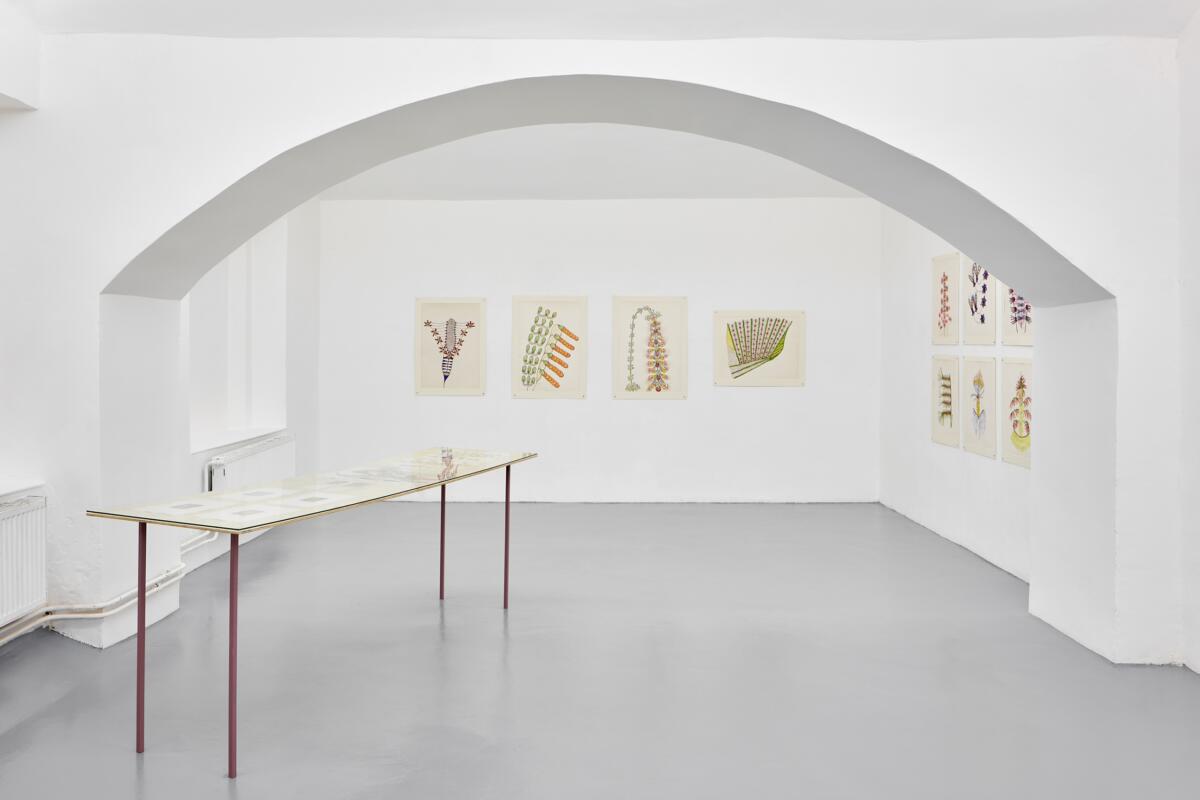![[EN/CZ] Anna Zemánková at Centre for Contemporary Art FUTURA](https://blokmagazine.com/wp-content/uploads/2022/01/anna-zemankova-futura-ph-jan-kolsky-09-1200x800.jpg)
[EN]
More Beautiful Than Nature—The Work Of Anna:
Anna Zemánková never left us explicit instructions on how to read her work. The inspiration originated somewhere deep inside her and was more of an automated process than a rational one. As soon as her hand had drawn a shape, it informed the rest of them. The author herself claimed that she could not trace the exact source of her imagination. Nevertheless, she claimed it guided her to free herself from matter and to harmonize her soul. Even though these facts might evoke spiritualism in art – Hilma af Klint’s works might surface in the mind’s eye – Zemánková never spoke about any higher power at play. Being a self-taught artist, she had to devise her method – the faith in her ingenuity became one of her driving forces and a source of pride.
Many reasons come to mind why Zemánková stated that she exclusively created flowers. It is apparent she felt a natural affinity towards them, surrounding herself not only with fresh naturalia but also with their plastic versions. We may assume that her preference was influenced by the folk costumes of the Haná region, herbariums, and memorials, or perhaps even decorative curves of art nouveau. However, even a mere glimpse assures us that these flowers were not formed from terrestrial matter. They often vibrate with an almost ominous mystique, and in her drawings, we may occasionally observe spatial bodies and formations (allegedly, she was a firm believer in extraterrestrial civilisations). It is often unclear whether we are standing face to face with objects of orders of magnitude a few times lower or higher – whether we are witnessing tissues and division of cells, seaweed, and amorphous protozoa, or planetary explosions. This mental vegetation defies the laws of physics, and the only thing binding it to the Earth is that it indeed often grows upwards. Otherwise, it exists in the vacuum rather than in humid air.
Zemánková consistently prided herself on her themes being unique and never recurring. It is truly astonishing how many permutations one can achieve when using the idea of a plant as a material. Even though walking through the exhibition I can’t wrap my head around the multitude surrounding me, I find a specific, fertile quality precisely in this overflow emanated by her drawings, paintings, and collages, which leads to a certain out-of-body experience. Various authors dealt directly with ontological processes, libidinal desire to self-impregnate, in their interpretations of the work because the world of plants naturally provides such potential. However, Zemánková’s matter is inanimate or otherworldly, more enticing and succulent than nature itself, which makes it even sinful at times.
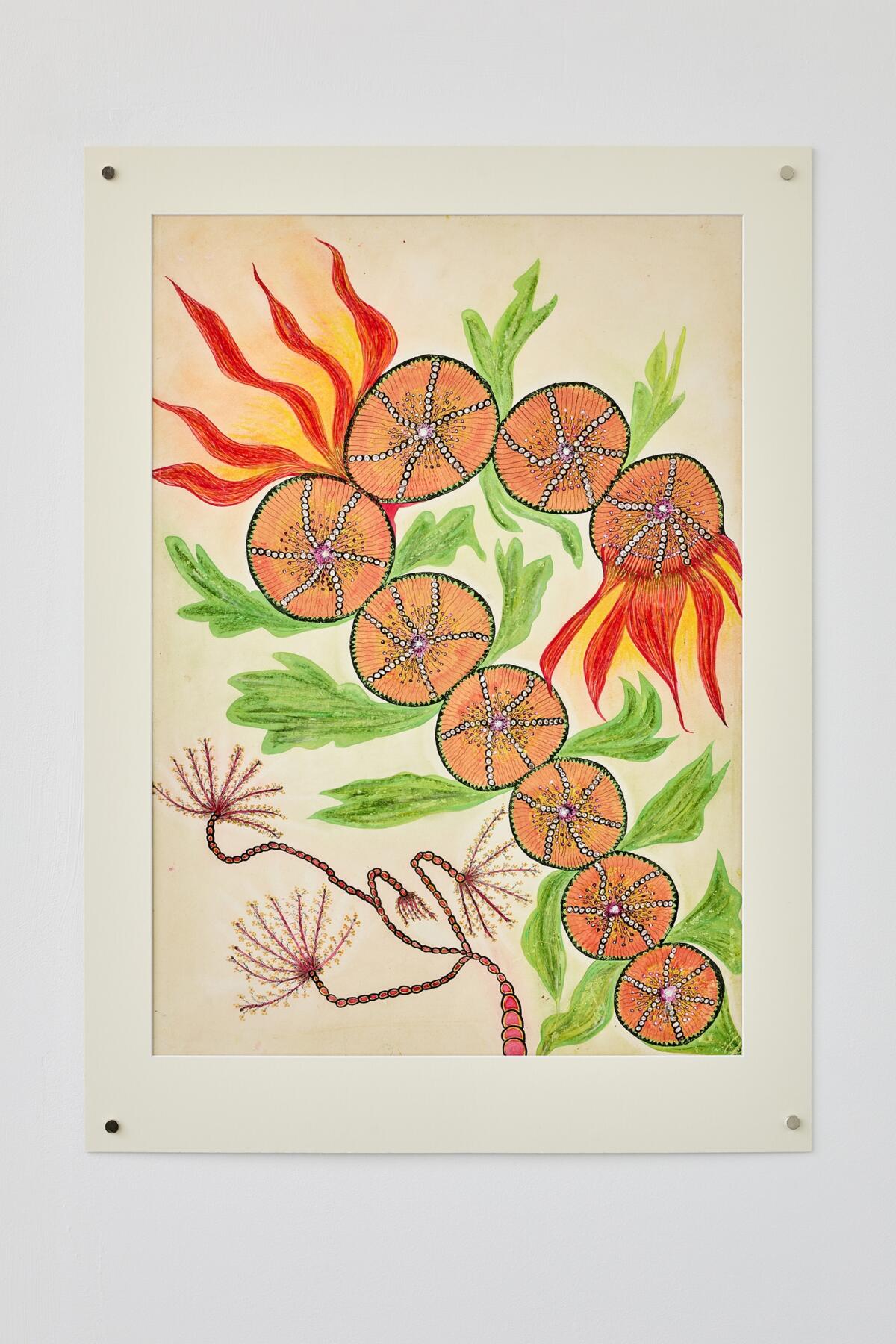
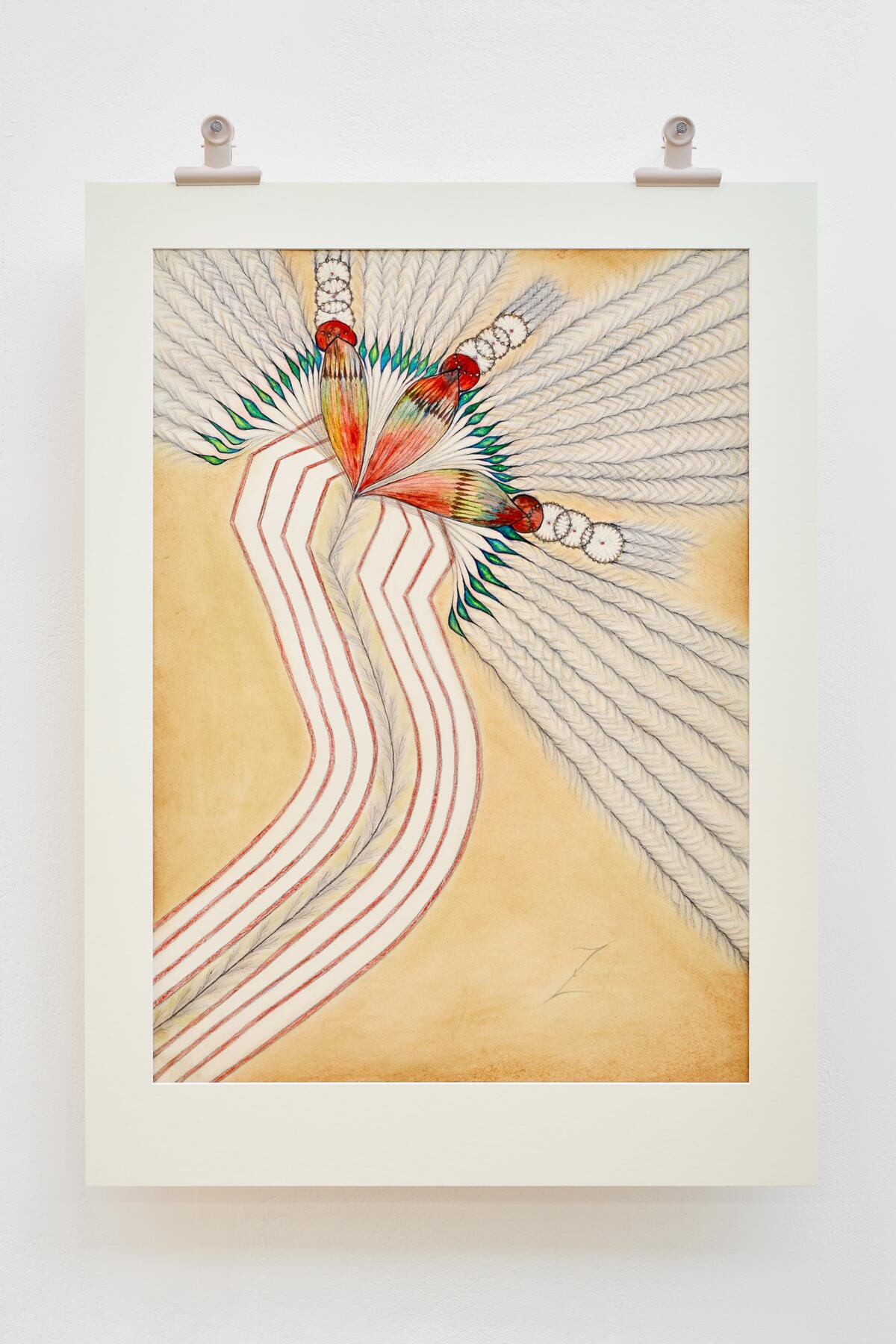

If we met Anna in the street or visited her, we probably wouldn’t see her as a particularly sophisticated woman – she created a “fairytale kingdom” at her home in Nusle, surrounding herself with kitschy things and a deluge of fresh as well as artificial flowers. That’s because, in her living space, she preferred conventional beauty. However, in her artistic practice, it was the other way around – she seems to be bolder and imaginative in her creative expression. Remarkably, these two aesthetic concepts split so thoroughly, giving rise to art as a sacred vessel where the author stored her creative tension and spiritual exaltedness. The same schism between the author – “an ordinary woman” – and her extraordinary work occurs in almost a superhuman focus often necessary to produce tens of thousands of dots and lines in the drawings’ details, which Zemánková always produced without errors and smudges, with the skill and rigours which would have also been necessary for her job as a dental technician.
Initially, the artist worked with pencil and tempera paint, watercolour, then with dry pastel, oil pastel, and crayons. The details were first marked with ink, then a pen and marker. There was a time she used to cover her drawings with cooking oil to seal them – it didn’t occur to her that the oil would soak in and leave an unsightly stain around the contours. She composed collages out of paper snippings, then sewed beads and sequins into them. She used a needle to punch a paper placed on styrofoam and printed onto it using blind blocking with blunt objects, then fixed these protrusions in a relief. She starched, cut, and painted synthetic satin.
All of that took place on her kitchen table.
To Become Her Own Person—The Life Of Anna:
It’s perhaps only in the details where one can see that the hand of an older person drew them with no artistic training. Anna Zemánková (1908-1986), already at an early age, painted landscapes based on postcards and showed interest in studying art. However, she followed her parent’s advice instead and was trained as a dental technician, opening her practice in Olomouc. At forty, she moved with her husband and children from Moravia to Dejvice in Prague. In 1960, her sons found a small suitcase in the attic that was full of paintings. When they learnt that she was the author, they persuaded her to return to making art. This was because they felt that their mother was going through a personal crisis – she was experiencing long-term discontent. The children had long left their nest and didn’t require her care anymore, the relationship with her husband also wasn’t harmonious. She was holding in an inordinate amount of energy that needed to explode.
Zemánková’s artistic work soon became a form of art therapy and she succumbed to it completely. Similar to the other representatives of the art brut category, in which she is usually included, her yearning for a creative realisation arrived out of the blue – not in her youth, but when she was middle-aged. It was a means of self-preservation and pleasure – the meticulous work brought her satisfaction and even a deeper potential of becoming “her own person”. She used to wake up around four in the morning and started to paint while listening to classical music, unable to create in silence. These morning seances, somewhere between night and day, between dreaming and awakeness, became a ritual. Her hand first covered contours of the largest volumes, then it resorted to shaping the smaller units, and finally, it came to the lacing of tiny details. Her dentistry practice then manifested itself in the miniature details – in almost filigree fillings and arabesques of her artworks.
Art was becoming a more and more significant centre of her life. The author immersed herself into inventing new techniques with a childlike vigour and had a strong desire to exhibit her creations. Zemánková organized Open-Door Days at her home, where she invited her neighbours and also her children’s friends from the art world. She would hang her artworks on the walls, on the improvised boards, and even on wardrobes. When, in the sunset years of her life, first one and later the other leg had to be amputated because of her diabetes, she moved to a retirement home in Mníšek pod Brdy, where due to the limited space and motor skills she created increasingly minuscule artworks until the last moments of her life.

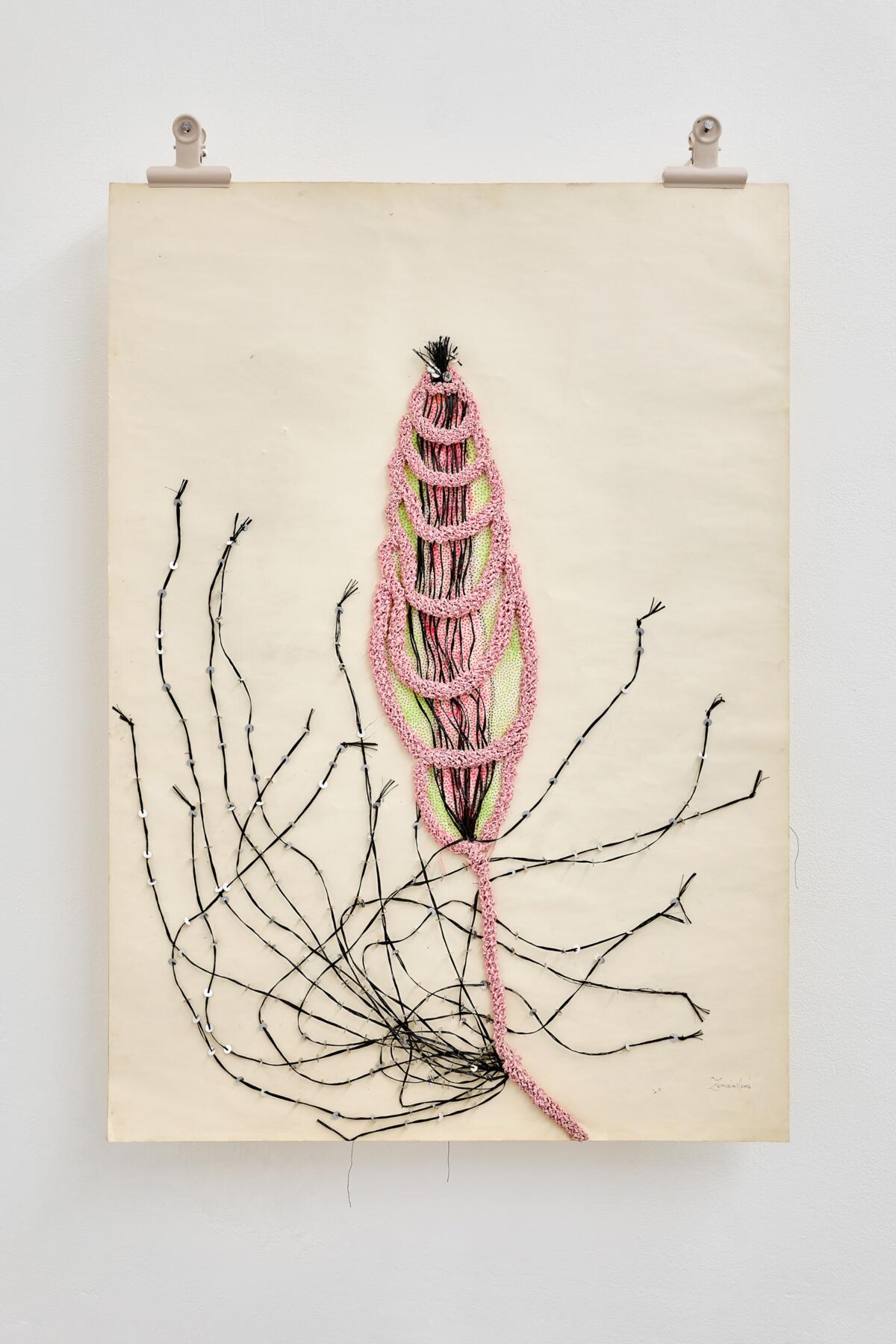
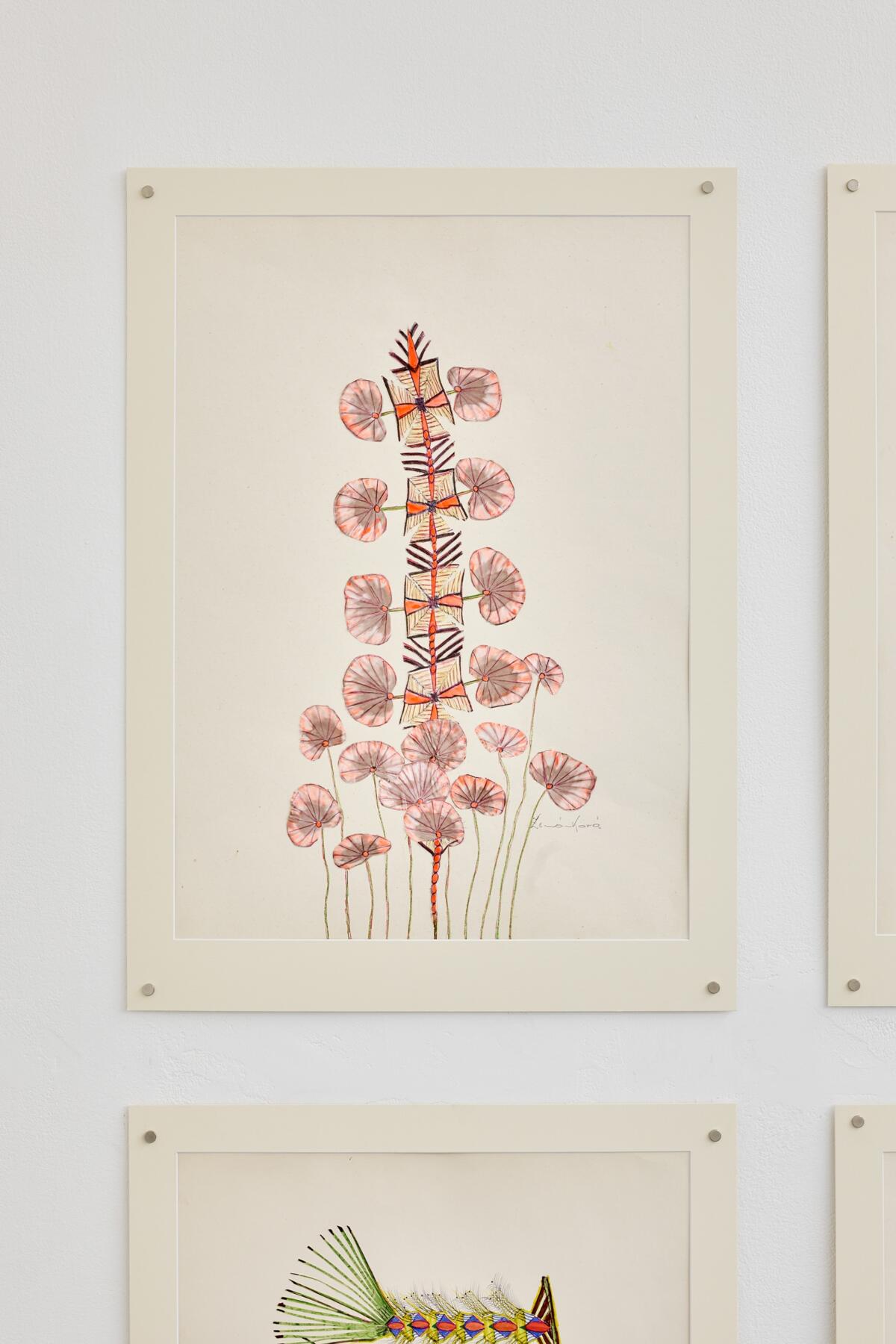
Atlas Of It All—The Framing Of Anna:
Zemánková’s artworks usually find themselves in a more formal environment, more often in the context of modern art and art brut, than contemporary art. They are frequently dressed in mats, framed, and displayed under glass. Here, we can meet them naked, which makes them somehow lightened and more youthful. The nakedness allows for the truth of the circumstances of their origin to come out – thanks to the various stains and impurities on their margins – as well as the fact that some of the artworks of the same series slightly vary in size or similar. This exhibition thus unintendedly manages to thematise the aspect of institutional framing – in the philosophical as well as literal meaning. The project resembles more an anthology than a retrospective. More than an effort to write an encyclopaedia definition, I aim to tell a sensory tale without objective criteria, to illustrate (and truly, even amplify the impression of) the evolution from the concrete shapes to more abstracted signs, from tempera and watercolour towards pastels and other techniques, ending in the room with vaulted ceilings by artworks characterised by the use of synthetic materials and sculpturally emerging into space. The notice board and the table might remind us of the artworks’ origin on the kitchen table and the activity of pinning on the notice board on the Open-Door Days.
In the first room I see objectification of ontology – the image of cell division of a maggot in an apple was destined to open the exhibition. Two quartets of artworks from the early 60s offer the comparison of the more concrete and static, almost herbarium-like line, in opposition to a more abstract and dynamic, conflicted one which sticks its fiery, poisonous tongues out on us. It gives us the opportunity, for the first and the last time, to observe watercolour – a technique that the author soon refrained from.
The second room under the glass ceiling opens with two pastels that were created as a parable of the birth of her two sons – Slavomír and Bohumil. It’s their first opportunity to hang next to each other and to function as a memento of motherhood, which the author herself considered being her key role. On the pillars, we find four totemic, meticulous drawings of stunning detail that the sun touches at least sometimes. The wooden board by the light is inhabited by, among others, shaggy-looking butterflies that haven’t been shown yet.
Pastels from the second half of the 60s dominate the largest room- the extensive color scale of this material allowed for a simple layering, solid line, and provided superb control. This soft material especially appealed to Zemánková. At that point, she was already suffering from glaucoma, which gradually blurred the edges of her vision into the dark, and similarly, she lightens up the centres of the paintings here. She brilliantly draws the flowers’ curves, as if they were magical shields or petrified animals.
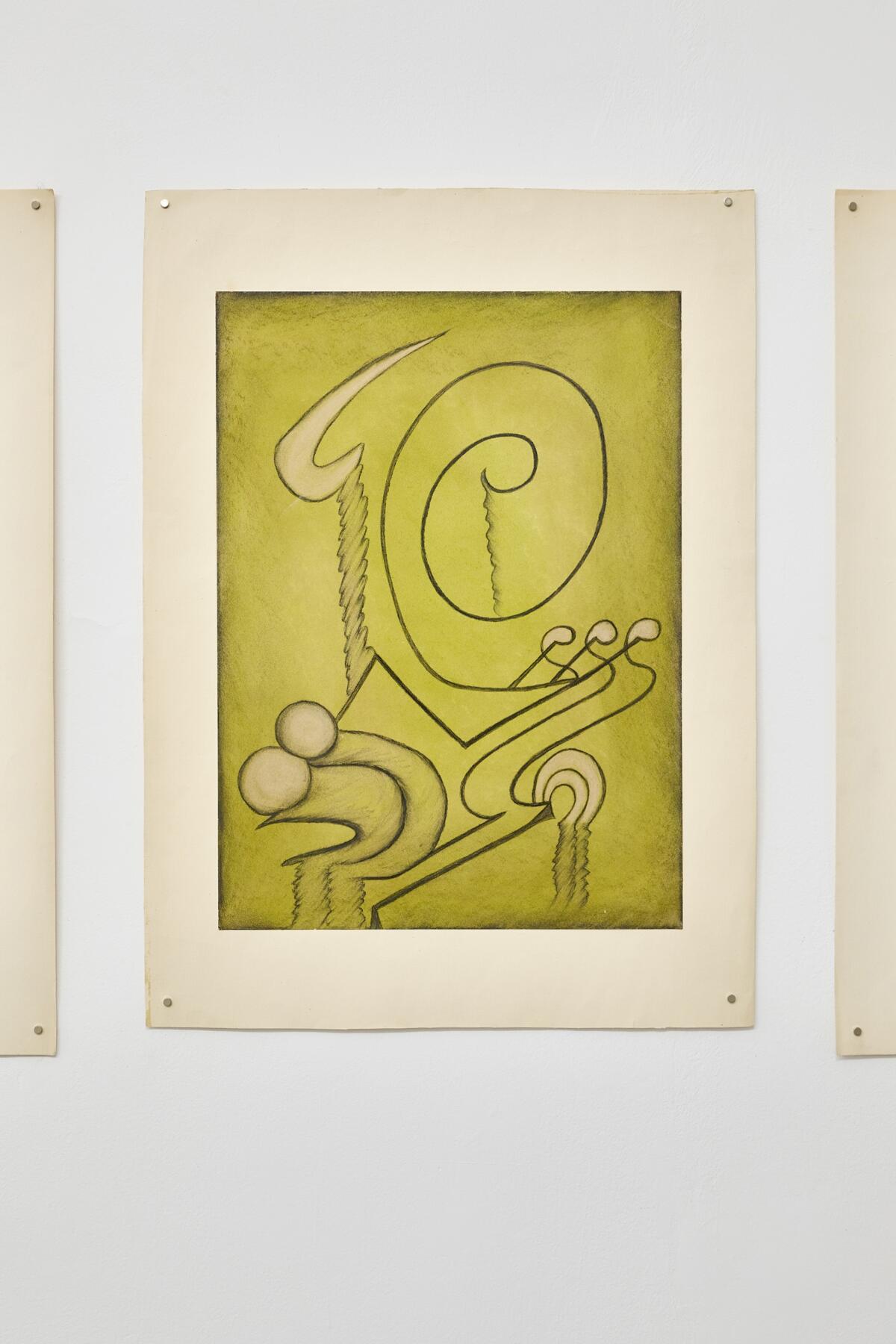
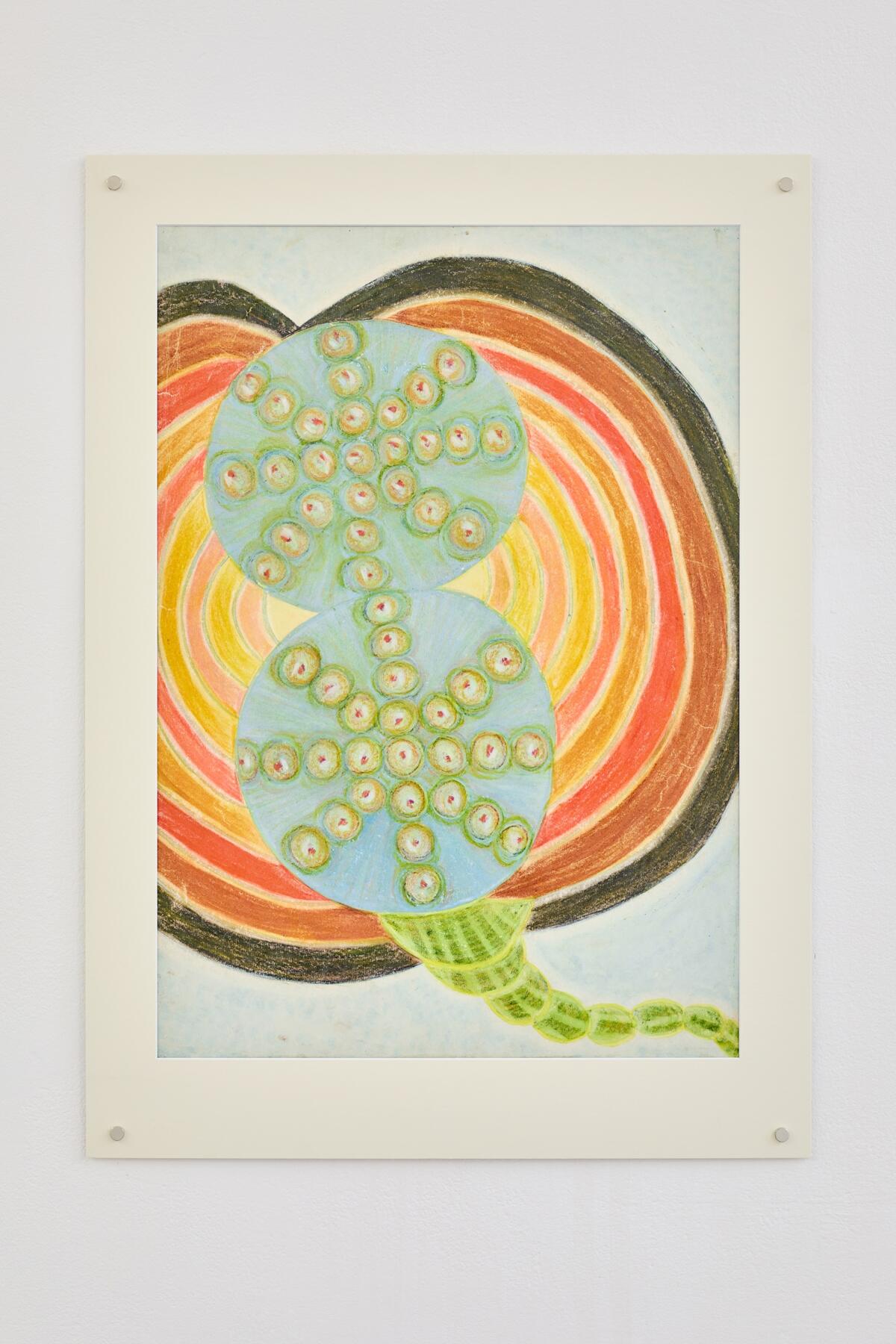
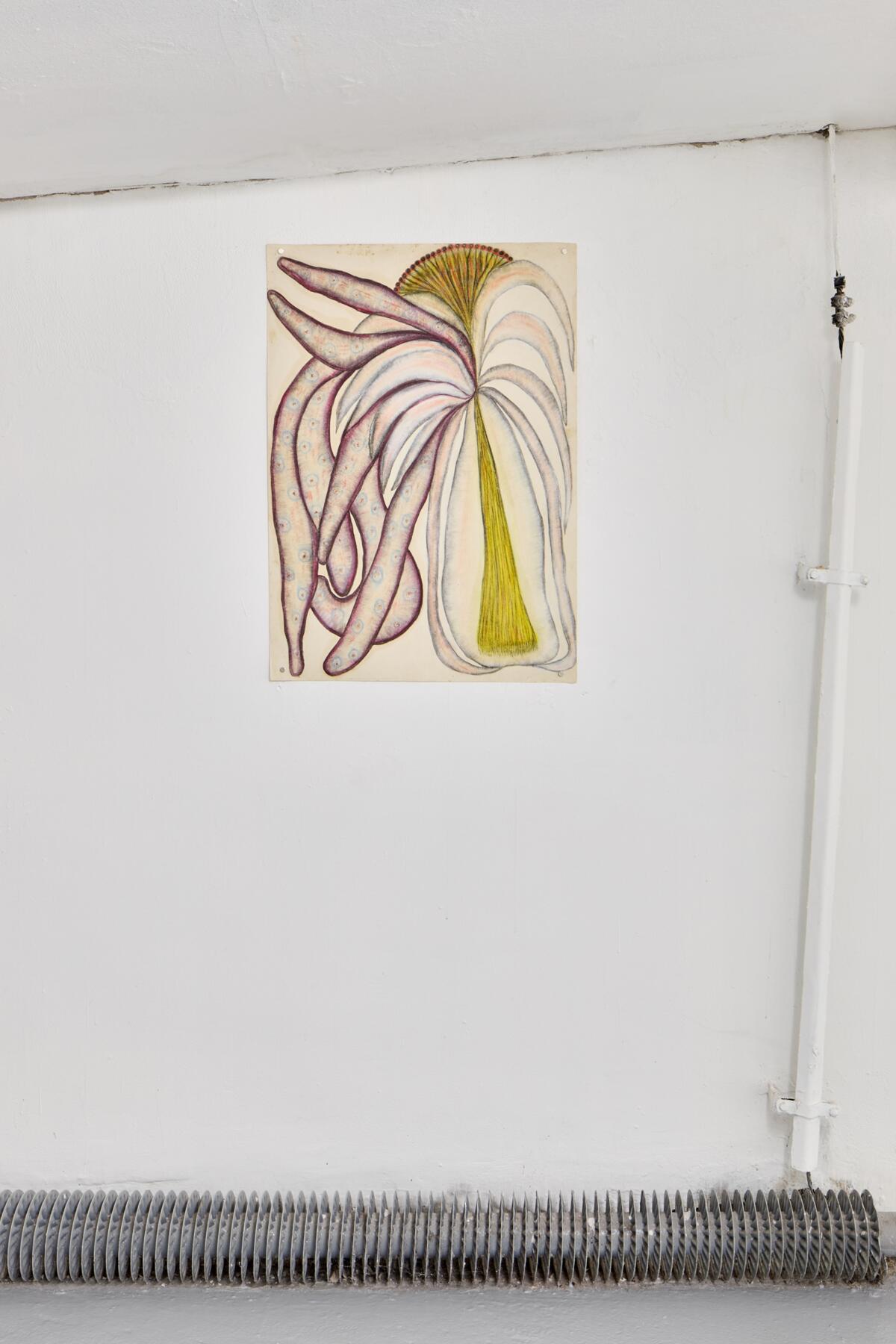
The small, hybrid room evokes a darkened cosmic cabin infected by alien protozoa and berries of slime. Here, drawings are characterised by the gradual simplification of the sign, and a more rounded shape. The wooden boards, originally from the decorative wall of the flat in Nusle, seem to talk in the language of runes.
Four pictures are hanging in the hallway that are inspired by Cubism, more in their visual aspect than content. Zemánková didn’t build a relationship towards the history of art, but we can imagine that from watching TV she was familiar with eminent artists the likes of Picasso, and at one point she indeed set off toward geometrisation in abstraction. These attempts were merely epigonic, though, and she soon steered clear of them.
Subsequently, the author worked mostly with synthetic satin that she dyed and glued to paper. In the room with a vaulted ceiling, we discover examples of this practice on the six pieces of jolly herbarial neo-forms. The monumental artworks on the wall at the back represent the peak of her oeuvre using paper, which she frays, layers, folds, and models skilfully. The three works crocheted from plastic bast even arise from their format and seem to release themselves from their surface. At its end, a brown pastel drawing symbolically sums up the entire exhibition, and its pores lay bare the plant atlas of it all.
—Lukas Hofmann
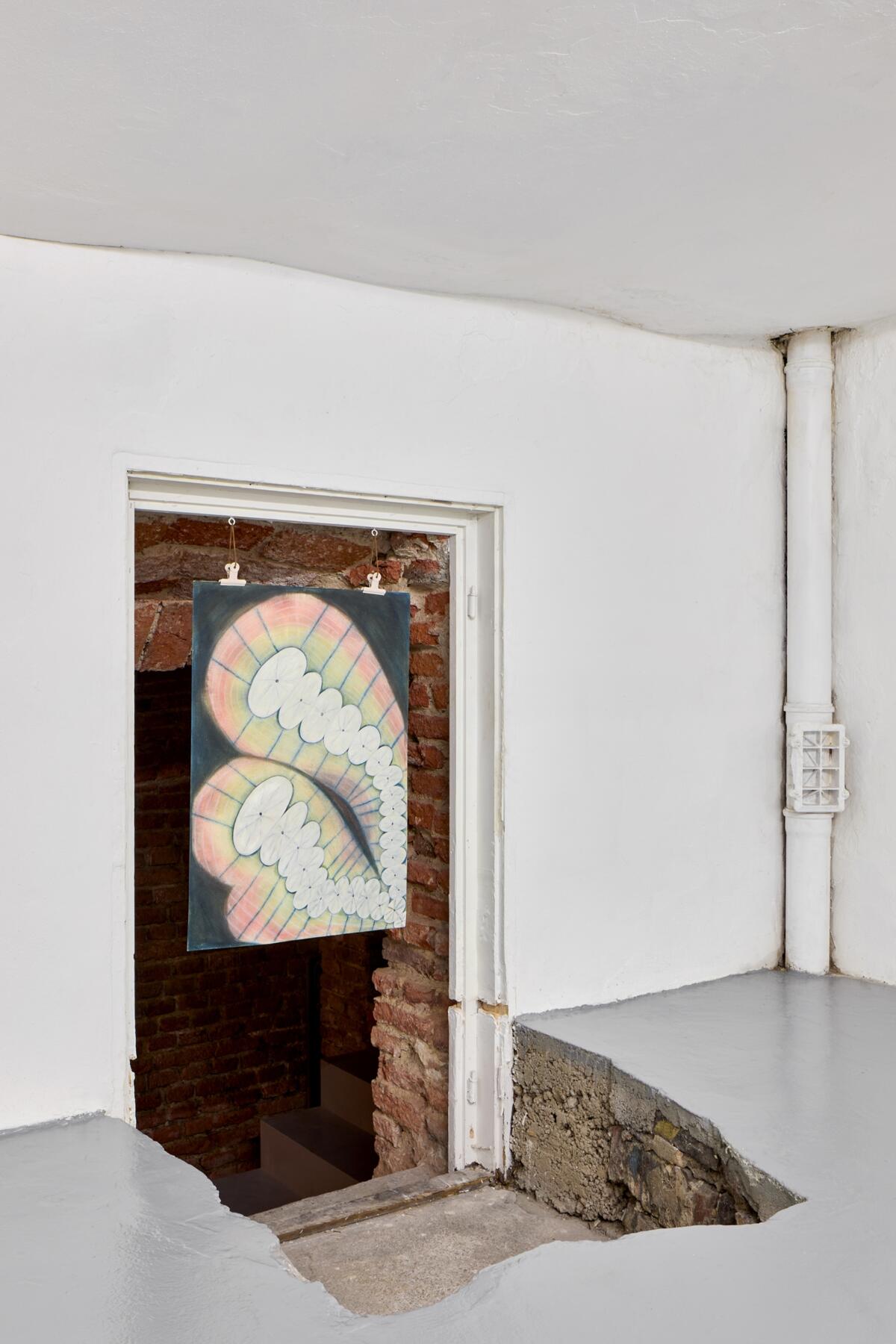

[CZ]
Krásnější než příroda – Dílo Anny:
Anna Zemánková nám nikdy nezanechala srozumitelný návod, jak číst její dílo. Inspirace přicházela odněkud z hlubin nitra, spíše automatickým než racionálním procesem. Jakmile ruka nakreslila jeden tvar, ten ovlivnil všechny tvary příští. Autorka sama tvrdila, že zdroj vnuknutí nedokáže přesně lokalizovat, ale jistě jí pomohl odpoutat se od hmoty a harmonizovat duši. Přestože tato fakta připomínají spiritistické umění – na mysli vytane například Hilma af Klint – Zemánková se nevyjadřovala o nějaké duchovní síle. Jako autodidaktka musela najít vlastní metodu – důvěra ve vlastní vynalézavost se pak stala jedním z jejích hnacích motorů i zdrojem pýchy.
Nabízí se mnoho důvodů, proč Zemánková konstatovala, že stále tvoří jen květiny. Zřejmě k nim cítila přirozenou afinitu, a obklopovala se jimi i jejich verzemi z plastu. Můžeme se domnívat, že její preferenci ovlivnily i hanácké kroje, herbáře a památníky, nebo třeba dekorativní secesní křivky. Ale již letmé zhlédnutí nás ubezpečuje, že tyto květiny neutvořila zemská matérie. Mnohdy vibrují až zlověstnou tajemností, v kresbách pozorujeme tu a tam tělesa a útvary z vesmíru (pevně prý věřila v mimozemské civilizace). Často není jasné, jestli stojíme tváří v tvář reprezentacím předmětů o několik řádů menších nebo větších – sledujeme-li tkáně a dělící se buňky, mořské řasy a amorfní prvoky, anebo planetární exploze. Mentální vegetace tu vzdoruje zákonům fyziky, a jediné, co ji poutá k zemi, je to, že opravdu velmi často roste zdola nahoru. Jinak ale spíš funguje ve vzduchoprázdnu než ve vlhkém vzduchu.
Zemánková si důsledně zakládala na tom, aby každý námět byl jedinečný a nikdy se neopakoval. Je vskutku udivující, kolika permutací může člověk dosáhnout, když využívá ideu rostliny jako tvůrčí materiál. Přestože mi stále jde hlava kolem, když výstavou procházím, tohle přeplnění vnímám jako specifickou, plodivou kvalitu jejího díla, kterou emanují její kresby, malby a koláže, a která vede k určitému vyvtělení. Různí autoři se ve svých interpretacích přímo zabývali ontologickými procesy, libidinální touhou sebe-oplodňování. Svět rostlin totiž přirozeně takové potenciály skýtá. Ovšem hmota Zemánkové je jaksi neživotná či nadpozemská, lákavější a šťavňatější než příroda sama, a tím chvílemi i hříšná.
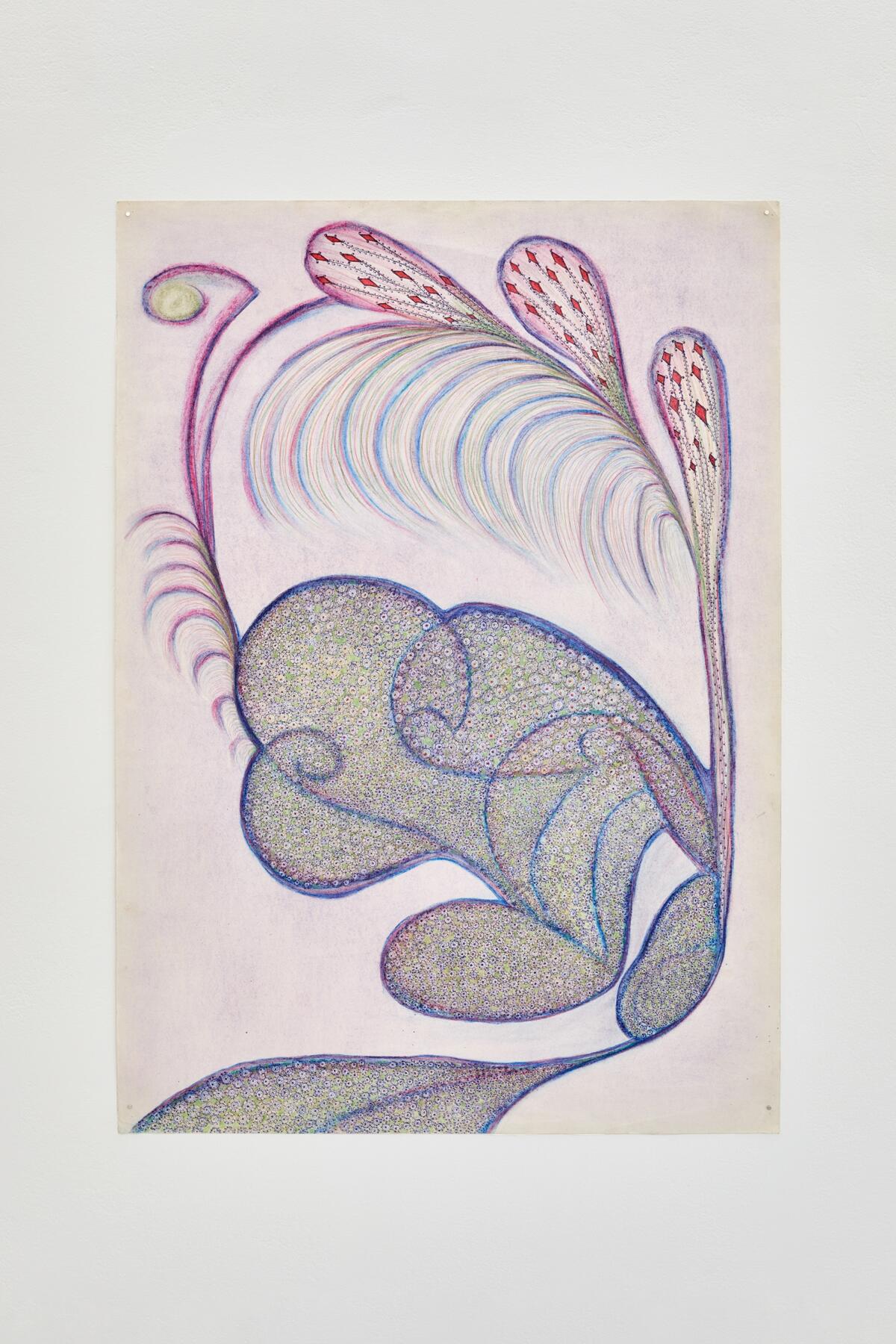
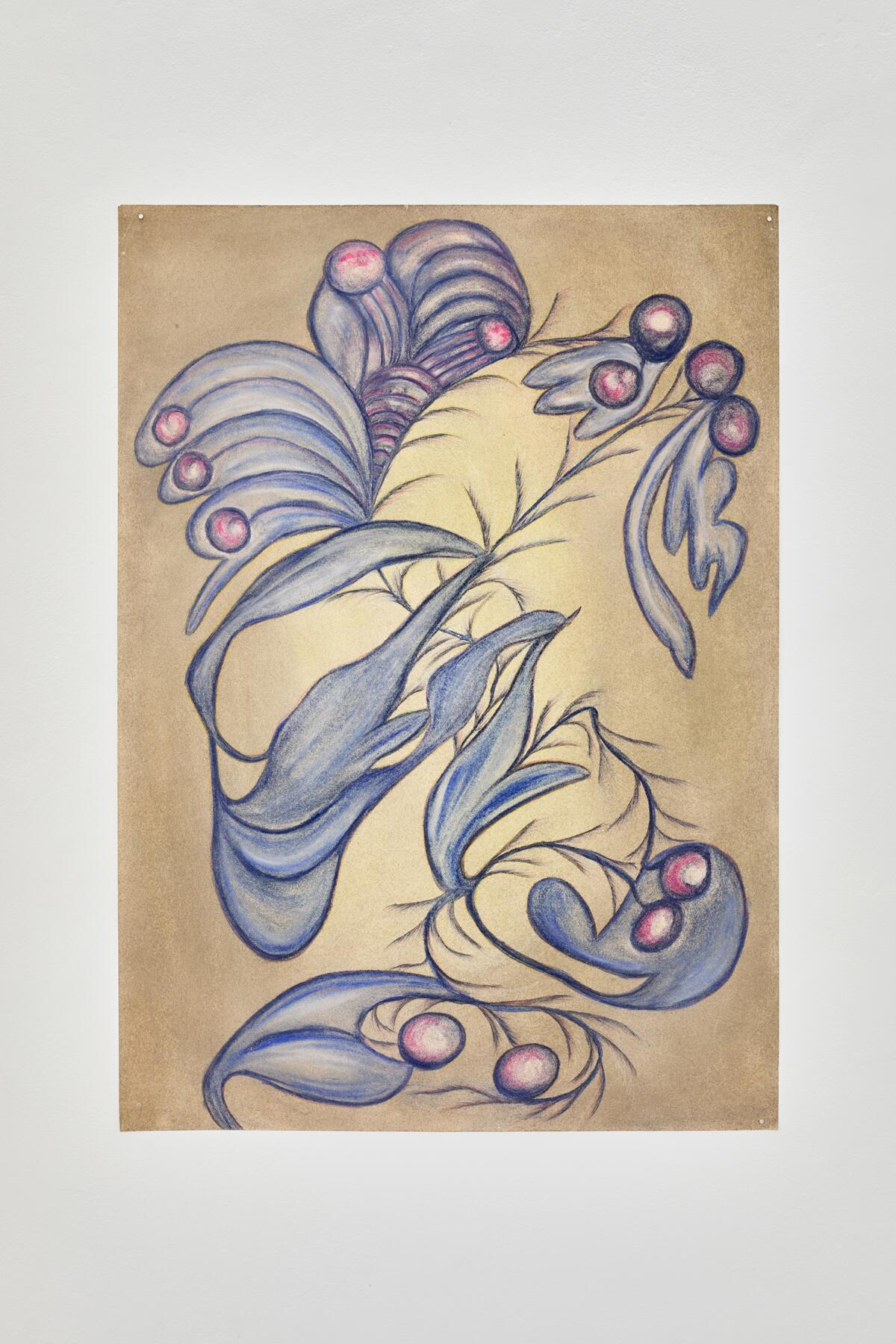
Kdybychom Annu potkali na ulici nebo navštívili, asi bychom ji nepovažovali za bůhvíjak sofistikovanou ženu – doma v Nuslích si vytvořila ‚pohádkové království‘, obklopena kýčovitými předměty a záplavou nejen pravých, ale i umělých květin. Ve svém životním prostoru totiž preferovala konvenční krásu. V umělecké praxi tomu je naopak – v kreativním projevu působí odvážněji a imaginativně. Je podivuhodné, že se tyto dva estetické koncepty mohly tak důkladně rozštěpit, a dát vzniknout umění jako posvátné nádobě, do které ukládala svoje tvůrčí napětí a spirituální exaltovanost. Ke stejnému rozkolu mezi autorkou – ‚běžnou ženou‘ – a jejím výjimečným dílem dochází v takřka nadlidském soustředění mnohdy potřebném k produkci desetitisíců teček a čárek v detailech kreseb, které vždy tvořila bez chyb a šmouh, se zručností a důsledností podobnou její původní práci dentistky.
Na počátku umělkyně pracovala s tužkou a temperou, akvarelem, pak se suchým pastelem, mastnou křídou a pastelkami. Detaily zaznamenávala nejdřív inkoustem, pak propiskou a mikrofixem. Jednu dobu kresby potírala kuchyňským olejem, aby je zafixovala – neuvědomila si tehdy, že se nasákne a zanechá kolem kontur nevábnou skvrnu. Komponovala koláže s ústřižky papíru. Všívala do nich korálky ci flitry. Na polystyrenovém podkladu propichovala jehlou papír a protlačovala jej za užití slepotisku tupými předměty, tyto výstupky pak fixovala v reliéfu. Škrobila, stříhala a pomalovávala umělý satén.
Tohle všechno se odehrávalo na jejím kuchyňském stole.
Stát se sama sebou – Život Anny:
Snad jen v detailech tu člověk pozná, že je nakreslila ruka staršího, umělecky neškoleného člověka. Anna Zemánková (1908-1986) již v mládí malovala krajiny podle pohlednic a projevovala zájem studovat umění, místo toho se ale na radu rodičů vyučila zubní techničkou a založila si ordinaci v Olomouci. Ve věku asi čtyřiceti let se přestěhovala s mužem a dětmi z Moravy do pražských Dejvic. Roku 1960 její synové našli na půdě kufřík plný maleb, a když zjistili, že je tvořila ona, přimeli ji, aby se ke tvorbě navrátila. Cítili totiž, že jejich matka prochází osobní krizí – zažívala dlouhodobé neuspokojení, děti už dávno vylétly z hnízda a nevyžadovaly její péči, vztah s manželem také nebyl harmonický. Dusila v sobě obrovské množství nahuštěné energie, která potřebovala explodovat.
Tvorba se pro Zemánkovou záhy stala formou arteterapie, které propadla. Podobně jako u jiných představitelů kategorie jménem art brut, do níž bývá řazena, se naléhavá touha po kreativní realizaci dostavila nečekaně – nikoli v mládí, ale až ve středním věku. Byla prostředkem sebezáchovy i rozkoše – minuciózní práce přinášela spokojenost, a dokonce hlubší potenciál ‚stát se sama sebou‘. Pravidelně vstávala kolem čtyř hodin ráno a za poslechu klasické hudby počínala kreslit. V tichu, bez hudebního doprovodu, nemohla tvořit. Z těchto ranních seancí někde mezi nocí a dnem, snem a bděním, se stal pravidelný rituál. Ruka nejdřív obsahovala kontury největších objemů, pak se uchýlila k tvarování menších celků, a nakonec ke krajce nejmenších detailů. Dentistická praxe se tehdy projevila na miniaturních detailech – takřka filigránových výplních a arabeskách jejích děl.
Umění se stávalo stále výraznějším středobodem jejího života. S dětinskou vervou se hroužila do vynalézání nových technik, a své kreace toužila vystavovat. U sebe doma organizovala Dny otevřených dveří, na něž zvala sousedy, a také přátele svých dětí z uměleckého světa. Obrazy při nich věšela na stěny, na improvizované nástěnky i na skříně. Když jí byla v důsledku cukrovky na sklonku života amputována nejdřív jedna a pak i druhá noha, přestěhovala se do domu důchodců v Mníšku pod Brdy, kde kvůli omezenému prostoru a motorickým schopnostem vytvářela až do poslední chvíle stále miniaturnější dílka.
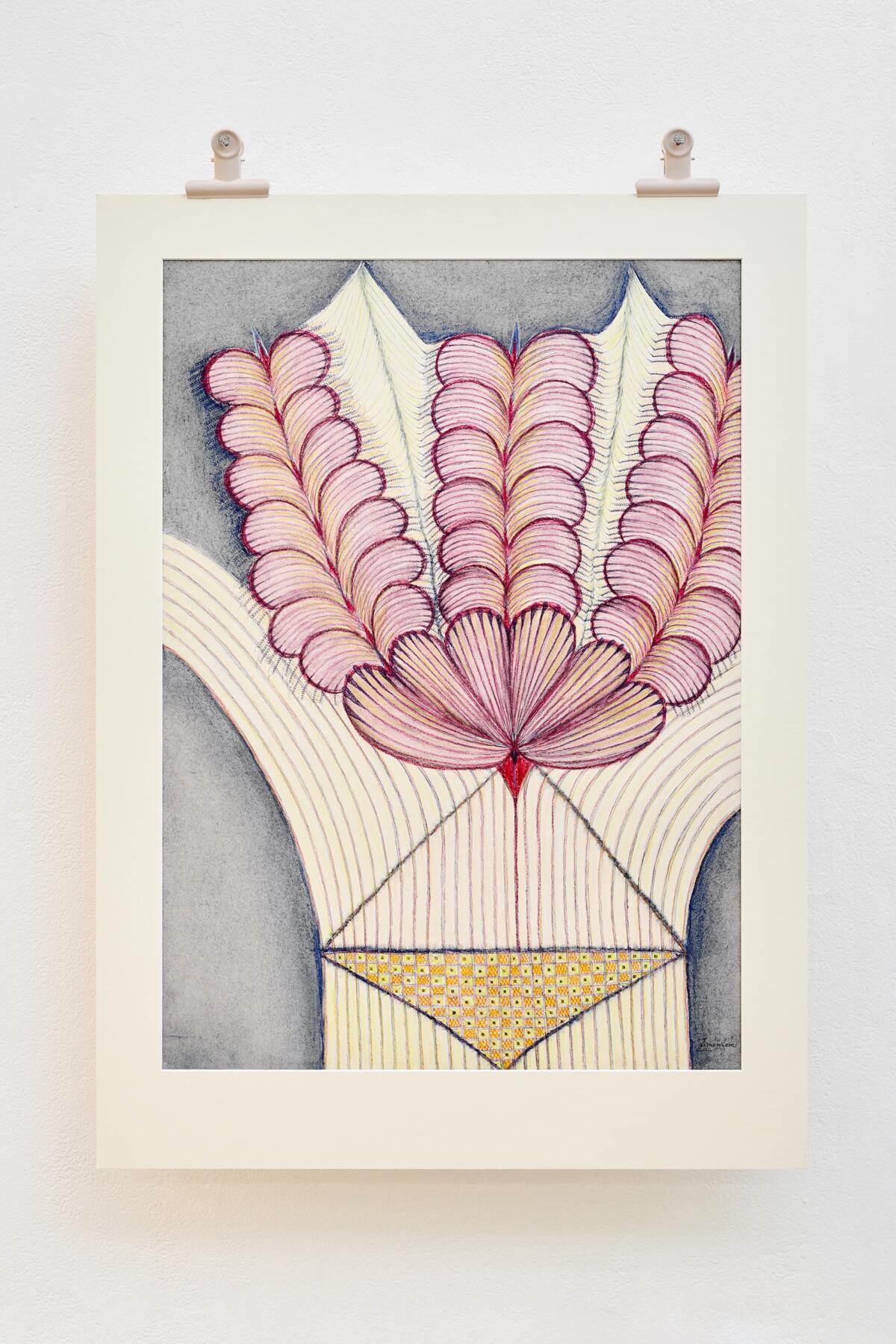
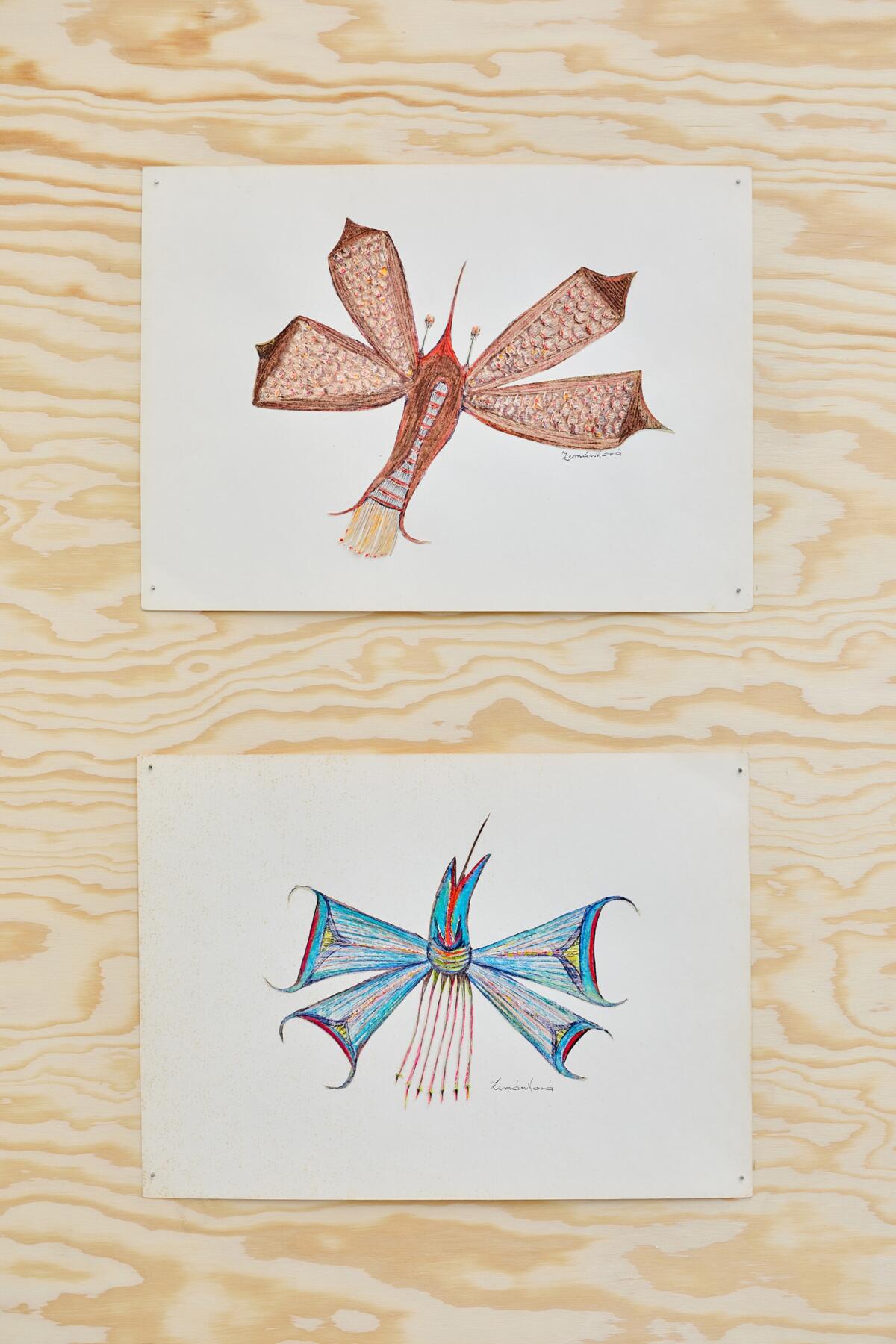

Atlas toho všeho – Rámování Anny:
Obrazy Zemánkové se obvykle ocitají ve formálnějším prostředí, v kontextu spíše moderního umění a art brut, než toho současného. Často bývají oděné do paspart, rámů, a vystavené pod sklem. Zde je potkáváme nahé, a tím poněkud odlehčenější a mladistvější. Díky takové nahotě lépe vystupuje pravda o okolnostech jejich vzniku – díky nejrůznějším skvrnám a nečistotám na jejich okrajích – stejně jako fakt, že se některá díla stejných cyklů lehce liší velikostí, apod. Výstava tak mimovolně tematizuje aspekt institučního rámování – a to jak ve filozofickém, tak v doslovném smyslu. Projekt se podobá více antologii než retrospektivě. Spíš než psaním encyklopedického hesla je snahou vyprávět smyslový příběh bez objektifikovatelných kritérií, ilustrovat (a popravdě i umocnit dojem) vývoj od konkrétních tvarů po abstrahovanější znaky, od tempery a akvarelu směrem k pastelu a jiným technikám, který se ukončuje v klenuté místnosti díly, charakteristickými použitím syntetických materiálů a plasticky vystupujícími do prostoru. Nástěnka a stůl snad připomenou i okolnosti vzniku děl na kuchyňském stole a ‚nástěnkování‘ při Dnech otevřených dveří.
První místnost vnímám jako zpředmětnění ontologie – obraz buněčného dělení červa v jablku je předurčen k tomu, aby výstavu uváděl. Dvě čtveřice děl z raných 60. let nabízejí k porovnání konkrétnější a statickou, takřka herbářovou linii, v opozici proti abstraktnější a dynamické linii plné konfliktu, vyplazující na nás ohnivé, jedovaté jazyky. Máme zde možnost poprvé a naposledy pozorovat akvarel – techniku, od níž autorka záhy upustila.
Druhou místnost pod skleněnou střechou uvádějí dva pastely, vytvořené jako podobenství narození dvou synů – Slavomíra a Bohumila. Poprvé mají příležitost viset pospolu a působit jako memento mateřství, které autorka sama vnímala jako své klíčové poslání. Na sloupech místnosti nacházíme čtyři totemické, filigranské kresby s uchvacujícími detaily, kterých se alespoň občas dotkne slunce. Dřevěnou nástěnku u světla zabydleli mimo jiné roztřapacení motýli, kteří dosud nebyli jinde vystaveni.
Největší místnosti dominují pastely z druhé poloviny 60. let – tato technika svou širokou barevnou škálou dovolovala jednoduché vrstvení, pevnou linku a dobrou kontrolu. Tento poddajný materiál měla Zemánková v mimořádné oblibě. Měla v té době již zelený zákal, při němž se postupně hrany vidění rozpíjejí v temnotě, a podobně tomu i zde prosvětluje střed kreseb. Bravurně kreslí křivky květin, jako by to byly magické štíty či petrifikovaná zvířata.
Malá, hybridní místnost evokuje potemnělou kosmickou kajutu infikovanou mimozemskými prvoky a plody slizu. Kresby se vyznačují postupným zjednodušováním znaku, zaoblováním tvaru. Dřevěná prkénka, původně pocházející z dekorativní stěny jejího nuselského bytu, jakoby promlouvala jazykem run.
V chodbě visí čtyři obrazy zřejmě inspirované kubismem, a to spíš vizuálně než obsahově. Zemánková neměla vytvořený vztah k dějinám umění, můžeme si ale představit, že byla z televize seznámena s velikány typu Picassa a v jednu chvíli se vskutku vydala směrem geometrizace v abstrakci, tyto pokusy ale byly epigonské, a brzy od nich upustila.
Posléze autorka začala pracovat hlavně s umělým saténem, který barvila a lepila na papír. V klenuté místnosti nalézáme příklady této praxe na šestici rozjařených herbářových novotvarů. Monumentální díla zadní stěny představují vrchol její práce s papírem, který třepí, vrství, ohýbá a zručně modeluje. Tři práce háčkované z umělého lýka dokonce vystupují ze svého formátu, a zdánlivě se odpoutávají od plochy. Celou výstavu nakonec symbolicky shrnuje hnědá pastelová kresba, jejíž póry obnažují rostlinný atlas toho všeho.
–Lukas Hofmann
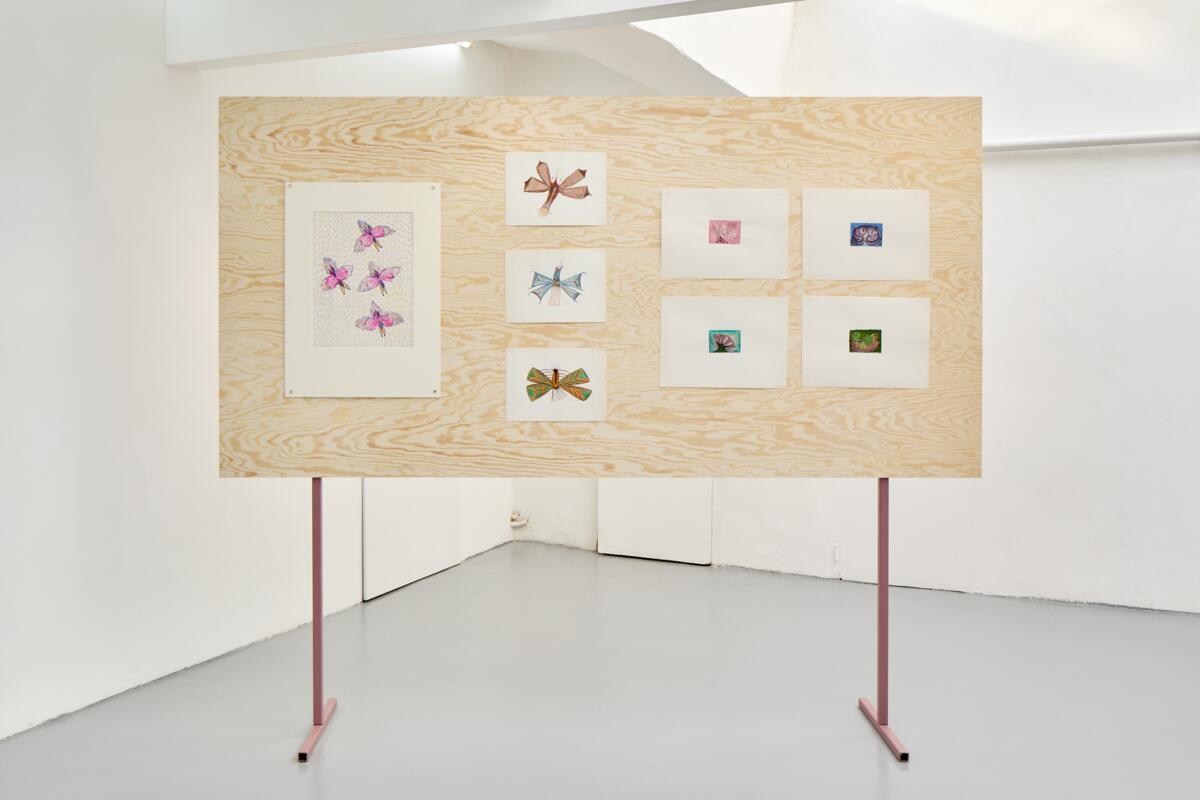

Imprint
| Artist | Anna Zemánková |
| Place / venue | Centre for Contemporary Art FUTURA |
| Dates | 7.12. 2021–16.1. 2022 |
| Curated by | Lukas Hofmann |
| Photos | Jan Kolský |
| Website | futuraprague.com/ |
| Index | Anna Zemánková FUTURA Lukáš Hofmann |

